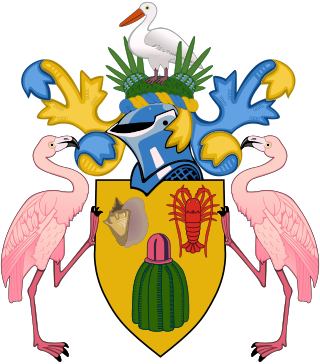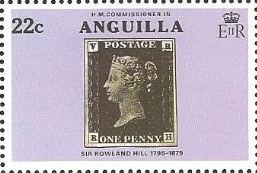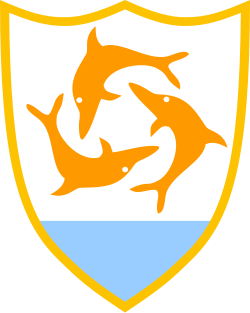
Anguilla is a British Overseas Territory in the Caribbean. It is one of the most northerly of the Leeward Islands in the Lesser Antilles, lying east of Puerto Rico and the Virgin Islands and directly north of Saint Martin. The territory consists of the main island of Anguilla, approximately 16 miles long by 3 miles (5 km) wide at its widest point, together with a number of much smaller islands and cays with no permanent population. The territory's capital is The Valley. The total land area of the territory is 35 square miles (91 km2), with a population of approximately 15,753 (2021).
The history of Anguilla runs from the beginning of human habitation, probably via settlement from South America, through its colonization by the English in the early modern period, to the present day. Following a series of rebellions and a short-lived period as an independent republic during the 1960s, Anguilla has been a separate British overseas territory since 1980.

The coat of arms of the territory of Nunavut was granted by a warrant of Roméo LeBlanc, Governor General of Canada, dated 31 March 1999, one day before the territory of Nunavut, Canada, was created. The same document specified the flag of Nunavut.

The national flag of Anguilla, a British overseas territory, consists of a Blue Ensign with the British flag in the canton, charged with the coat of arms of Anguilla in the fly. The coat of arms consists of three dolphins in a circular formation, which were featured on the earlier Anguillan flag, and which stand for friendship, wisdom and strength. The white in the background stands for peace, and the light blue represents the sea, as well as faith, youth, and hope.

The coat of arms of the Bahamas contains a shield with the national symbols as its focal point.

The coat of arms of Toronto, Ontario, Canada, was designed by Robert Watt, the Chief Herald of Canada at the time, for the City of Toronto after its amalgamation in 1998. The arms were granted by the Canadian Heraldic Authority on 11 January 1999.
Anguillan Creole is a dialect of Leeward Caribbean Creole English spoken in Anguilla, an island and British Overseas Territory in the Caribbean. Although classified as a dialect of Leeward Caribbean Creole English spoken in Saint Kitts and Nevis, Antigua and Montserrat due to a common British colonial history, it is actually closer to the British Virgin Islands and Saint Martin varieties of Virgin Islands Creole. The number of speakers of Anguillan Creole is below 10,000. Anguillan Creole does not have the status of an official language.

The flag of the British Antarctic Territory was granted on 21 April 1998. It features the coat of arms granted on 1 August 1963, a year after the British Antarctic Territory, a British Overseas Territory, was created. Previously, the Territory was a part of the Falkland Islands Dependencies and used the same flag. On 30 May 1969, a blue ensign with the British Antarctic Territory coat of arms in the fly was introduced as a civil ensign.

The coat of arms of the British Antarctic Territory was first granted in 1952, when the territory was still a dependency of the Falkland Islands.

The coat of arms of the British Virgin Islands consists of a green escutcheon (shield) charged with a woman in a white dress and gold-coloured sandals, holding a lit golden oil lamp and surrounded by eleven other golden lamps. Adopted shortly after the islands became a Crown colony, it has been the coat of arms of the British Virgin Islands since 1960. The escutcheon dates from the early 19th century and is featured on the flag of the territory. The woman and the lamps represent Saint Ursula and her companions, the namesake of the islands.

The coat of arms of Montserrat consists of an escutcheon (shield) charged with a woman in a green dress holding a golden harp and a black cross. In use since at least 1909, it has been the official coat of arms of the Caribbean island of Montserrat since the island became a British Crown colony in 1962. The escutcheon is featured on the flag of the territory.

The coat of arms of the Turks and Caicos Islands consists of a gold-coloured escutcheon (shield) charged with a conch shell, lobster and a cactus, supported by two flamingos, and topped with a pelican in the crest. Adopted three years after the islands became a Crown colony, it has been the coat of arms of the Turks and Caicos Islands since 1965. The escutcheon is featured on the flag of the territory. The previous badge featured two mounds of salt in front of a ship, with doors added to the mounds after they were reportedly mistaken for igloos.
James Ronald Webster (2 March 1926 – 9 December 2016) was a politician from Anguilla. After ending the Saint Christopher-Nevis-Anguilla federation in 1967, he served as the island territory's first Chief Minister from 10 February 1976 to 1 February 1977 and again from May 1980 to 12 March 1984.

The coat of arms of Namibia is the official heraldic symbol of Namibia. Introduced at the time of independence in 1990, it superseded the earlier coat of arms used by the South African administration of the territory.
The flag and emblem of Perak are state symbols of Perak, Malaysia. These two symbols are distinct from each other in style. Similar to other states of Malaysia with Malay royalties, both the flag and arms of Perak are influenced by royalties, Islam, and political symbols of the state.

The coat of arms of Malawi is based on the earlier heraldic arms of Nyasaland. It is supported by a lion and a leopard, above a scroll reading "Unity and Freedom". A rising sun in a black field, like in the lower field in the shield, is also present in the flag of Malawi.

The flag of the British Leeward Islands was the flag of the Federal Colony of the Leeward Islands. It was a Blue Ensign with a badge. The colonies under the Federal Colony had their own badges from 1909. The Governor-in-chief of the Leeward Islands used a Union Flag defaced with the coat of arms.

The Coat of arms of Penang is largely based on the coat of arms of Penang first granted to the Settlement of Penang, then in the Federation of Malaya, by a Royal Warrant of King George VI dated 11 September 1949.

Anguilla is a British overseas territory in the Caribbean, one of the most northerly of the Leeward Islands in the Lesser Antilles. It consists of the main island of Anguilla itself, together with a number of much smaller islands and cays with no permanent population.
Operation Sheepskin was a British military operation in the Caribbean, aimed at restoring British rule to the island of Anguilla, after the island had declared itself as an independent Republic. The British government dispatched two Royal Navy ships and 300 soldiers of the 2nd Battalion, Parachute Regiment and 22 officers of the Metropolitan Police to restore order to the island. The operation was a success and British troops were met with no resistance by the islanders, as they had wanted the island to remain a British territory but with direct association with Great Britain, separate from Saint Kitts and Nevis, of which they were a part.















